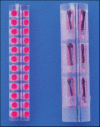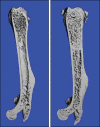High-throughput screening of mouse gene knockouts identifies established and novel skeletal phenotypes
- PMID: 26273529
- PMCID: PMC4472125
- DOI: 10.1038/boneres.2014.34
High-throughput screening of mouse gene knockouts identifies established and novel skeletal phenotypes
Abstract
Screening gene function in vivo is a powerful approach to discover novel drug targets. We present high-throughput screening (HTS) data for 3 762 distinct global gene knockout (KO) mouse lines with viable adult homozygous mice generated using either gene-trap or homologous recombination technologies. Bone mass was determined from DEXA scans of male and female mice at 14 weeks of age and by microCT analyses of bones from male mice at 16 weeks of age. Wild-type (WT) cagemates/littermates were examined for each gene KO. Lethality was observed in an additional 850 KO lines. Since primary HTS are susceptible to false positive findings, additional cohorts of mice from KO lines with intriguing HTS bone data were examined. Aging, ovariectomy, histomorphometry and bone strength studies were performed and possible non-skeletal phenotypes were explored. Together, these screens identified multiple genes affecting bone mass: 23 previously reported genes (Calcr, Cebpb, Crtap, Dcstamp, Dkk1, Duoxa2, Enpp1, Fgf23, Kiss1/Kiss1r, Kl (Klotho), Lrp5, Mstn, Neo1, Npr2, Ostm1, Postn, Sfrp4, Slc30a5, Slc39a13, Sost, Sumf1, Src, Wnt10b), five novel genes extensively characterized (Cldn18, Fam20c, Lrrk1, Sgpl1, Wnt16), five novel genes with preliminary characterization (Agpat2, Rassf5, Slc10a7, Slc26a7, Slc30a10) and three novel undisclosed genes coding for potential osteoporosis drug targets.
Figures





References
-
- Moore MW. High-throughput gene knockouts and phenotyping in mice. Ernst Schering Res Found Workshop 2005; 50: 27–44. - PubMed
-
- International Mouse Knockout Consortium, Collins FS, Rossant J, Wurst W. A mouse for all reasons. Cell 2007; 128: 9–13. - PubMed
-
- Collins FS, Finnell RH, Rossant J. Wurst W. A new partner for the International Knockout Mouse Consortium. Cell 2007; 129: 235. - PubMed
LinkOut - more resources
Full Text Sources
Other Literature Sources
Molecular Biology Databases
Research Materials
Miscellaneous

